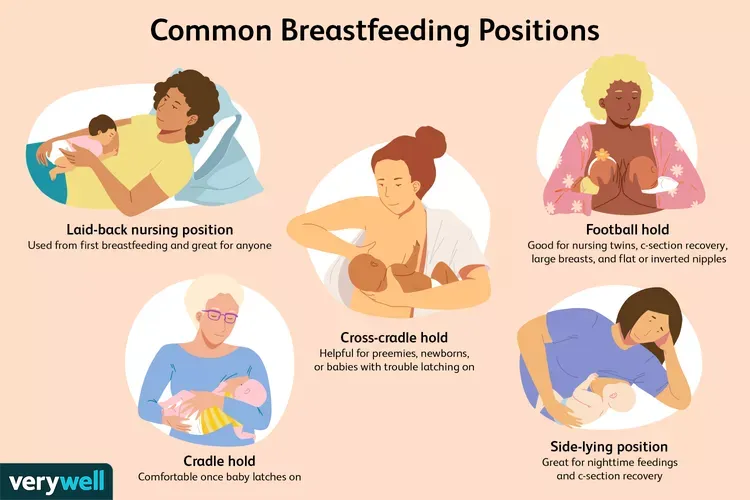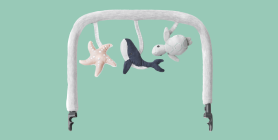
Here you are -- you finally think you have this breastfeeding thing down. No more sore nipples, baby is gaining weight, sleeping in longer stretches, and you’re finally starting to feel like your old self again. Then suddenly you have a drop in your milk supply in what seems like overnight. This sudden change isn’t uncommon to nursing mothers, but it can cause momentary panic in a new mom and leave you wondering why this is happening. Many things can cause a once robust milk supply to drop. It could be that you went back to work and are now separated from your baby for longer stretches during the day, perhaps you had an illness, have had recent stress in your life, return of your menstrual cycle, or just plain haven’t been taking good care of yourself. Whatever the reason for this drop, there are things you can do to increase your milk supply and bring it back up to the level it once was.
Can you increase your milk supply after it decreases?
 Yes. The fastest way to increase your milk supply is to ask your body to make more milk. Whether that means nursing more often with your baby or pumping – increased breast stimulation will let your body know you need it to start making more milk.
Yes. The fastest way to increase your milk supply is to ask your body to make more milk. Whether that means nursing more often with your baby or pumping – increased breast stimulation will let your body know you need it to start making more milk.
How long does it take to increase your milk supply?
It usually takes about 3-5 days before you see an increase in your supply.
Here are 10 tips on how to increase your milk supply and get it back up to where it once was:
1. Get lots of rest and take care of yourself. It is so important that you’re getting enough sleep. Try to choose a sleeping arrangement that allows for the maximum amount of sleep for mom and baby. Have the right swaddler or sleep sack for the age of your child. This ensures they’re not only as comfortable and warm as possible, but these kinds of products are specifically designed to help your baby feel safe and secure to help them sleep longer and better.
2. Drink lots of water! I can’t stress this enough. Every time you breastfeed or pump, drink a glass of water.
3. Have a “nurse in” with your baby. Take at least 24 hours and snuggle in with the baby. Have water, snacks and diapers at hand and nurse as often as baby will nurse. Be sure to have a comfortable nursing pillow to make the experience as comfortable as possible for you and your baby. Practicing skin to skin during this time also helps to increase milk supply. This time together for mom and baby not only will increase the frequency of nursing, but also provide some extra rest for Mom, which also helps to increase prolactin level and helps with your milk supply.
4. Consider pumping. Try to pump 8-10 times in 24 hours, 10-15 minutes at a time, every day after breastfeeding until you notice your supply increasing. You’re pumping to increase your milk supply, so don’t worry if nothing comes out at first. 5. Apply a warm compress to your breasts for a few minutes before breastfeeding or pumping. Combined with a breast massage, the warm compress will help to get the milk flowing. 6. Try taking galactagogues. Galactagogues are herbal supplements that help to get your milk supply back. The most commonly used are Fenugreek, brewers yeast, blessed thistle and alfalfa. Before taking a galactagogue talk to your health care provider to see if they are safe for you. 7. Take away the pacifier. If your baby has a need to suck – let them fulfill that suck on your breasts. Any extra stimulation on your breasts will help to increase your milk supply. 8. Eat foods know to help increase your milk supply. Foods such as oatmeal, garlic, carrots, fennel, nuts, green papaya, sesame seeds and ginger all work to help increase your milk supply. 9. Make lactation cookies. There are many recipes online that are easy to make and yummy to eat. These cookies contain ingredients that will work to give your supply a boost. 10. Don’t stress out. Try to keep things relaxed and focus on the positive things. Your milk supply will return.Breastfeeding is incredible and beautifully beneficial. But it doesn’t come without its challenges and questions. There are a lot of common breastfeeding concerns among nursing mothers everywhere! Here are the answers to the most commonly asked breastfeeding and milk supply questions.
What is colostrum and why is it important?
Colostrum is the first milk your body produces. It’s a milky fluid that’s usually yellow/gold in color and thicker than breast milk. It usually lasts for 2-4 days after giving birth. Some call it the baby super food because colostrum is high in protein, vitamins, minerals and antibodies, all of which help build and support your newborn’s immune system. It fights infection, supports your baby’s immune system and gut function and can help prevent jaundice.
When does your milk come in?
For most mothers, they make colostrum for the first 2-4 days after birth. Breast milk typically comes in around day 3, 4 or 5.
Is it normal to have an uneven milk supply?
 Yes. It’s relatively common for one breast to produce more milk than another one. You might even notice your breasts are different sizes. There is no cause for concern as long as you’re comfortable and your baby is eating well and comfortable, too. You can ask and look into tips about how to produce more breast milk in your breast that isn’t producing as much.
Yes. It’s relatively common for one breast to produce more milk than another one. You might even notice your breasts are different sizes. There is no cause for concern as long as you’re comfortable and your baby is eating well and comfortable, too. You can ask and look into tips about how to produce more breast milk in your breast that isn’t producing as much.
How to increase milk supply when pumping?
- Pump more often
- Pump after nursing
- Pump both breasts at once
- Make sure you have good pumping equipment and that it’s working properly, i.e. learn how to use it, keep it clean, make sure you’re using the correct size of breast shield and speed
- Have a comfortable, dedicated space to pump
- Talk to a lactation consultant
6 Top Tips for Boosting Milk Supply
What affects breast milk?
- Stress and anxiety levels
- Not eating or drinking enough
- Supplementing with formula for multiple feedings a day
- Accompanying symptoms of getting sick, i.e. dehydration, vomiting, diarrhea, fatigue
- Certain medications or herbs
- Infective latch
- Not breastfeeding enough
- Hormonal or endocrine problems, such as PCOS, thyroid problems, diabetes
What should I eat and avoid while breastfeeding?
You need extra calories when breastfeeding (the amount depends on the mom’s lifestyle). Try to get those extra calories from nutritious foods, such as fruits, vegetables, lean meats and poultry, whole grains, dairy products (if your baby isn’t dairy intolerant).
- Foods and drinks you probably want to say no to:
- Foods that can give you gas, i.e. spicy foods, cabbage, broccoli, beans, etc.
- Fish that are high in mercury and other contaminants
- Fatty foods
- Alcohol
- Sugary drinks
- Caffeinated drinks (in moderation, too much may or may not affect you and baby)
- Milk (baby may have a dairy allergy or intolerance)

Will I have a menstrual cycle while breastfeeding?
It’s common not to have a menstrual cycle while breastfeeding because of hormonal changes. Every woman’s body is different if and when you have a menstrual cycle or when yours will return while or after breastfeeding. Some women get their periods back when their baby starts eating solid foods and they’re breastfeeding less.
How to dry up breast milk supply?
There are a few different ways to dry up your supply if you’re ready to stop breastfeeding or if your little one is weaning. Some women’s milk supply dries up in only a few days. For others, it may take weeks or months to completely dry up. Here are the most common:
- Stop breastfeeding. Use ice packs to help with any inflammation and occasionally hand express some milk to relieve engorgement. Some moms say to apply cabbage to help soothe engorged breasts, too.
- Go an hour or two longer between pumping sessions.
- Using certain birth controls and herbs have been shown to stop milk production.
What are the benefits of breastfeeding?
- The CDC has a list of benefits on its website for infants and mothers.
How often and long should you breastfeed?
- On average, newborns breastfeed 8-12 times a day, about every 2-4 hours, during the first few months of life. Some may cluster feed and nurse every hour, while other babies can go 3-5 hours during their longer stretches of sleep.
- As babies get older and as they start eating solid foods, the number of times they nurse a day will decrease.
- Every baby is different. Feeding on demand is recommended for newborns, and then as your baby gets older they should have a more predictable feeding schedule.
- The American Academy of Pediatrics and the World Health Organization recommend exclusively breastfeeding for a baby’s first 6 months of life and then for up to 2 years old or longer, along with offering solid foods as appropriate.
What are the (best/most common) breastfeeding positions?
- Cradle hold
- Cross-cradle hold
- Football hold
- Laid-back position
- Side-lying position
- Breastfeeding in a carrier

How do you store breast milk?
- Freshly expressed or pumped breast milk can be stored:
- For up to 4 hours at room temperature
- In the refrigerator for up to 4 days (the coldest part of the fridge is best)
- In the freezer for 6 months, in some cases up to 12 months
- Previously frozen, now thawed, breast milk can be stored:
- For 1-2 hours at room temperature
- For 1 day in the refrigerator
- Breast milk can be stored in clean storage bags, food-grade containers or bottles.
- Be sure to label the breast milk with the date it was expressed/pumped.
We hope this list of commonly asked breastfeeding and milk supply questions and answers was helpful. We also encourage you to find your own personal support system of other breastfeeding moms and a lactation consultant to help you along your breastfeeding journey.
Emotional Benefits of Getting Outside
Spending time in nature with your baby can strengthen the bond between you. The simple act of holding your baby close, feeling their warmth, and sharing new experiences together can create strong emotional connections. It’s also a wonderful way to reduce stress and improve your mood. When my littles were extra fussy, I’d take a walk around the neighborhood. Even though I don't live in an area with trails and surrounded by nature, simply behind outside changed everything. A little vitamin D does wonders!
Cognitive Development
Nature is a sensory wonderland for babies. The different sights, sounds, and smells can stimulate your baby’s senses and promote cognitive development. Watching leaves rustle, hearing birds chirp, and feeling the texture of a tree bark can all contribute to their learning and development.
All About Baby Carriers for Nature Adventures
Choosing the Right Baby Carrier
When it comes to selecting the best baby carrier for summer adventures, there are several options to consider.
Types of Baby Carriers:
- Wraps: Perfect for newborns, providing a snug and secure fit.
- Slings: Ideal for quick and easy use, offering good ventilation.
- Soft Structured Carriers: Versatile and comfortable for both parent and baby, suitable for longer trips.
Factors to Consider:
- Baby’s Age and Weight: Ensure the carrier is appropriate for your baby’s size and weight. For example, Ergobaby’s Embrace Newborn Carrier is perfect for the fourth trimester where baby is small and you’re looking for an easy way to stay close. As they grow, you’ll want to upgrade to an all-position carrier that’s meant for growing babies.
- Parent’s Comfort and Ergonomics: Look for carriers with padded shoulder straps and lumbar support if you’re planning on longer outings.
- Ease of Use: Choose a carrier that is easy to put on and take off.
- Climate and Breathability: Opt for carriers made of breathable fabrics to keep you and your baby cool in hot weather.
Safety Tips:
- Proper Positioning: Ensure your baby is seated correctly, with their legs in an "M" position and their head should be close enough to kiss.
- Checking for Wear and Tear: Regularly inspect your carrier for any signs of damage.
- Ensuring Adequate Support: Make sure the carrier provides proper support for your baby’s head and neck.
Exploring Nature with a Baby Carrier
Ideal Spots for a Nature Walk with Baby
- Parks and Gardens: Great for leisurely walks and picnics.
- Nature Trails and Forests: Perfect for more adventurous outings.
- Beaches and Lakesides: Wonderful for enjoying the water and sand, with the right carrier.
Activity Ideas
- Hiking: Enjoy a scenic hike with a hiking baby carrier that offers support and storage.
- Bird Watching: Use your carrier to keep your baby close while you explore and observe wildlife.
- Picnics: A carrier can free up your hands, making it easier to carry picnic supplies.


Advantages of Using Strollers for Nature Adventures


While baby carriers are fantastic for mobility and closeness, depending on the adventure of choice you might want to be a stroller along too.
There are a LOT of baby stroller options on the market. So we understand how confusing it can be to choose the one that’s right for your family. Not only are there a variety of brands, but a variety of strollers that serve different purposes.
There are a few types of strollers on the market:
- Full-sized stroller: This is typically the stroller parents thing of buying for all its versatility.
- Lightweight or umbrella stroller:These compact strollers are perfect for on-the-go adventures.
- Jogging stroller: Designed for parents who want to combine fitness with outdoor adventures.
- Double stroller: Designed for parents with multiple kids, especially twins.
- Car seat carrier: These strollers connect to a specific car seat. We don't typically recommend these as they can be unsafe for baby and uncomfortable for parents who are pushing.
Learn more about the types of strollers and which one would be best for you.
Benefits of Bringing a Stroller
- Storage Space for Gear: Ample room for carrying all your essentials like a diaper bag, beach toys and more.
- Shade and Weather Protection: Built-in canopies to shield your baby from the sun when they are lounging.
- Options: If you have more than one kid, you can stroll with one and carry the other. Or, if you’re getting warm or your little one is getting fussy, you can switch up their position from stroller to carrier or vice versa.
Safety Tips for Strollers
- Ensure your stroller is in good working condition. Make sure buckles are still buckling and that there are no rips or holes that could compromise your baby’s safety.
- Use sunshades or bug nets to protect your little one’s skin.
- Securing the baby properly: always buckle up your baby for safety even if you think they are old enough to go without the buckle.
Combining Baby Carriers and Strollers
For the ultimate flexibility, consider using both a baby carrier and a stroller on your outings.
Combining both options allows you to adapt to different situations. Use the carrier for more rugged trails and switch to the stroller for smoother paths or when your baby needs a nap.
Transition Tips
- Smooth Transitions: Plan stops where you can easily switch from carrier to stroller.
- Pack Light: Only bring essentials to make transitions easier.
Tips for a Successful Adventure
Planning Ahead
- Route Planning: Choose baby-friendly trails and parks. Check local mom groups or outdoor groups and get recommendations for the best outings for kids.
- Check Weather Conditions: Avoid extreme heat or unpredictable weather. Even with our most breathable carriers, when it’s hot, it’s hot. And having two bodies against each other in the heat will be naturally hot and sticky already.
- Packing Checklist: Include diapers, snacks, water, sunscreen, and a first-aid kit. These all-position carriers have storage pockets where you can fit some of the items easily!
- Stay Hydrated and Nourished: Pack healthy snacks to keep energy levels up and bring plenty of water for both you and baby.


Summer adventures with your baby are a wonderful way to create lasting memories and enjoy the beauty of nature together. From baby carriers to strollers, Ergobaby products are designed to provide comfort and ease for both you and your little one. So, gear up, get outside, and explore the world with your baby by your side.
Ready to embark on your own summer adventures? Check out Ergobaby’s range of baby carriers and strollers to find the perfect match for your family’s needs. Visit our website today and start planning your next outdoor excursion!



























